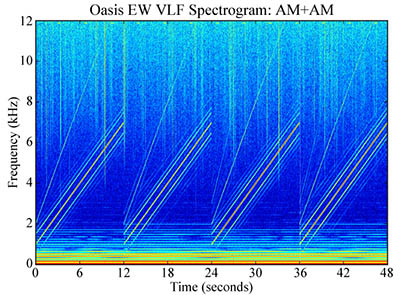Transionospheric Radio Wave Propagation
Transionospheric radio wave propagation occurs when a radio wave travels from the surface of the Earth into space and vice versa. The ionospheric plasma is an anisotropic, dispersive medium. It is also highly nonlinear. Waves can be scattered into other modes (at different frequencies) by density irregularities, for instance, and the presence of the wave itself can in turn affect the propagation of the wave (a principle known as "self-action"). Many types of irregularities occur at E and F-region altitudes. Our research aims to experimentally quantify the nonlinearities that occur in the D-region ionosphere.
The D-region ionosphere is responsible for the vast majority of radio wave attenuation. Understanding the physical processes that determine the level of attenuation is key to predicting radio wave signal intensities in space (for ground-based transmissions). For instance, without considering nonlinearities, a high-power HF radio wave might be attenuated by 20 dB as it traverses the D-region ionosphere. Thermal nonlinearities (produced by the radio wave heating the plasma) could produce an additional 5 dB of attenuation. Still other nonlinearities have yet to be fully investigated. In order to experimentally quantify these nonlinearities, we study the nonlinear interactions between multiple high-power radio waves.
One method to study these nonlinear interactions is by conducting ELF/VLF wave generation experiments at HAARP. Figure 1 shows the ELF/VLF waves observed when broadcasting two amplitude modulated HF signals with similar center frequencies. Multiple interharmonic modulation products are produced, as evidenced by the existence of ELF/VLF waves at specific frequencies. By quantifying the relative amplitudes of the received signals, we can quantify the relative importance of specific nonlinear interactions in the D-region ionosphere. We then apply this knowledge to validate transionospheric propagation models.


